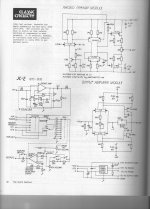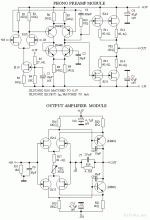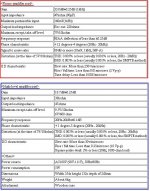The noise in the BAS article was exemplary, even better than the JC-2 but I could not find a spec on the data sheet (was there a graph?)
I am not sure if you mean the AGI 511.
If yes, I found these specs (but no graph)
George
Attachments
I recall someone insisting that phono preamps require a 36dB OL margin to avoid clipping (?) on dirt clods and their ilk. But what happens in a system after that
He must be a bit

See the chart from the old study from SHURE
880mVp (+42dB above 5cm/sec) is my choice for worst case (considering mild cartridge maladjustment) preamp input overload margin.
If the cartridge is properly attached to headshell and adjusted to the arm, I don’t think that it can ever output signal higher than the equivalent of +36dB above 5cm/sec
AGI 511 specs say max Phono input is 160mV (1kHz)
For a 5mV input, overload margin is 30dB
For a 2mV input, overload margin is 38dB
George
>Edit. Brad are you politely suggesting a limiter or soft clipper somewhere after the (non clipping) RIAA stage?
Last edited:
Yes, if one cannot get high OL out of hollow state, something is very wrong.
I recall someone insisting that phono preamps require a 36dB OL margin to avoid clipping (?) on dirt clods and their ilk. But what happens in a system after that?
Given that a lump of muck can give you a nice transient out into the 50KHz region and the first stage hasn't got that nice 20dB of HF attenuation (or even 40dB if you are entirely passive) you need a significant OL margin even if the output never goes above 2V worst condition.
Of course in any other field than audio one might clip the input...
Yes. Better to clip cleanly at line level, than hit the power amp hard and then complain that the output stage doesn't clip cleanly---IMO.>Edit. Brad are you politely suggesting a limiter or soft clipper somewhere after the (non clipping) RIAA stage?
Of course it must be defeatable, lest someone insist that he hears the clipper (despite levels being 20dB or more away from the clip point). Now a poor clipper with lots of distortion is not a good idea either.
Cordell shows an approach in Designing Audio Power Amplifiers (pg. 368). I also looked at some circuits (unpublished) in which the clamping diodes are driven by a replica of the input signal over most of the active range, after which the clipping is fairly soft.
In a preamp as it is evolving, with, I hope, high-end performance and sonics for a quasi-mid-fi price, following some old designs but with a twist, the first section is active feedback with the 75us pole, with 40dB gain at lowest frequencies. Then the following stage supplies a shelf with the gain at low frequencies another 20dB, falling to 0 dB at high frequencies. So the overall gain is 40dB at 1kHz, with an accurate RIAA characteristic. The first-stage "a.c. integrator" helps the high frequency overload a lot, and also works well after an inversion to drive the synthetic termination components.Given that a lump of muck can give you a nice transient out into the 50KHz region and the first stage hasn't got that nice 20dB of HF attenuation (or even 40dB if you are entirely passive) you need a significant OL margin even if the output never goes above 2V worst condition.
Of course in any other field than audio one might clip the input...
This is the MM input though, probably prefaced by another 20dB of flat gain for MC, there being a negligible advantage with low inductance cartridges for doing the synthetic term approach. It looks as if the MM section will have sufficiently low noise to almost work for MC, given sufficient gain afterwards, indeed quieter than many active stepup stages---in fact it is tempting to parallel a couple more JFETs. The external gain-determining impedances are quite small already and contribute little to the noise.
Are you sure, or taking the word of Saul as the truth? I've seen a lot of mentions of variable eq from before 1952 when he launched his first amplifier. It may have been the first, but would be nice to find out.
Well, you have the schematic.... I suppose you can compare with anything you have seen before it was produced.
But, its still good for LP fans to have the right EQ for their old record collection.. ..
THx-RNMarsh
@ Scott, got it, thank you.
@ Richard and other's...I can post a couple of pages from the
Radiotron Designers Handbook, they have some tests and circuits
from the 1952 publishing date.
If you have it, chapter 17 might be of interest are the published
test records from the industry. These go from 78 to 331/3 LPs.
They are all in written format so one has to read the specs.
I am unsure how to interperate it when some of the cps ranges
are +8dB etc. Are they to test the boarders of the EQ for the
preamp/cartridges recommended by each manufacturer/recording
company: for example, R.C.A., Colombia, etc?
I'll post them shortly
@ Richard and other's...I can post a couple of pages from the
Radiotron Designers Handbook, they have some tests and circuits
from the 1952 publishing date.
If you have it, chapter 17 might be of interest are the published
test records from the industry. These go from 78 to 331/3 LPs.
They are all in written format so one has to read the specs.
I am unsure how to interperate it when some of the cps ranges
are +8dB etc. Are they to test the boarders of the EQ for the
preamp/cartridges recommended by each manufacturer/recording
company: for example, R.C.A., Colombia, etc?
I'll post them shortly
Well, you have the schematic.... I suppose you can compare with anything you have seen before it was produced.
But, its still good for LP fans to have the right EQ for their old record collection.. ..
THx-RNMarsh
Agreed its good, but since the 'many curves' was almost solved by 1952 I find it odd no one thought of it before. Sadly all the references I have found to switchable curves on consoles of the time never mentions WHICH console. And life is too short when there are records to play.
@ Richard and other's...I can post a couple of pages from the
Radiotron Designers Handbook, they have some tests and circuits
from the 1952 publishing date.
If you have it, chapter 17 might be of interest are the published
test records from the industry. These go from 78 to 331/3 LPs.
They are all in written format so one has to read the specs.
Also-
Howard Tremaine's Classic book Audio Cyclopedia goes into phono EQ curves in great detail.
THx-RNMarsh
@ jcx
Since it was you who brought up dither..... today, music making and production uses DAW software..... such as Sonar, Pro Tools etc. -- Used on new and also on old recordings being remastered.
Do you know how often and which editing, processing (gain/level changes, mixing etc) et al will invoke an automatic dither to each step of the process? A wild guess, other than once, will suffice.
THx-RNMarsh
Since it was you who brought up dither..... today, music making and production uses DAW software..... such as Sonar, Pro Tools etc. -- Used on new and also on old recordings being remastered.
Do you know how often and which editing, processing (gain/level changes, mixing etc) et al will invoke an automatic dither to each step of the process? A wild guess, other than once, will suffice.
THx-RNMarsh
Last edited:
AFAIK all the processing is 32bit float, and final export allows choice of dithering, and dither type.
Dan.
.... if it stays in 32 or even 24 bit, it wont need dithering at all because all the accumulated distortion is below the noise floor? Right?
The Q&A at the bottom gives useful insights:
View attachment What is dither_ _ EarLevel Engineering.pdf
The video included is interesting.
Science Shows There's Only One Real Way to Listen to Music - Mic
THx-RNMarsh
Last edited:
Here are some examples:

http://www.diyaudio.com/forums/gallery/data/1916/1HiFreqEQ_1.jpg
and here:

http://www.diyaudio.com/forums/gallery/data/1916/2ELEFreqEQ_2.jpg
and here:

http://www.diyaudio.com/forums/gallery/data/1916/3RIAA_EQ_3.jpg

http://www.diyaudio.com/forums/gallery/data/1916/1HiFreqEQ_1.jpg
and here:

http://www.diyaudio.com/forums/gallery/data/1916/2ELEFreqEQ_2.jpg
and here:

http://www.diyaudio.com/forums/gallery/data/1916/3RIAA_EQ_3.jpg
Last edited:
there are those who argue that you need to dither going back to 24bit after processing at even 32 bit.
the answer to the question about where in the chain it happens and if it is automatic is way more complex, and changes when you talk about different versions of the same software (Pro Tools especially)
the math level that it takes place at also may vary dramatically, many plugins are used and they vary widely in their math precision, double, single 32, 48, etc.
So, No, there is no one answer. It depends greatly on the "driver" what happens to the audio.
Alan
the answer to the question about where in the chain it happens and if it is automatic is way more complex, and changes when you talk about different versions of the same software (Pro Tools especially)
the math level that it takes place at also may vary dramatically, many plugins are used and they vary widely in their math precision, double, single 32, 48, etc.
So, No, there is no one answer. It depends greatly on the "driver" what happens to the audio.
Alan
My question is even if you understand dither and there is a best practices that would give the best result, to what end will you do even with the information even if you know what is going on? What I mean by that is once the music has been final mixed and transferred to whatever final format used what could you possible do with the dither information? You can't change it after the fact, the music is finished and you certainly can't un-dither the signal, so what are we talking about here? Unless you plan on making your own digital recordings how is any of this relevant to choosing the music you like or ever even knowing what has been done in the chain. One problem is that many times the final mix has gone through multiple engineers hands and do those people even communicate this information from one to the other along the chain or is this just a part of the process that is out of any one person's control?
In reality I would be more interested in what speakers were used for mix-down than where dither was applied. You can't hear dither, it is at or close to the LSB and when do you in any modern music care really about that level of sound, what music ever gets down to the LSB except for a fade-out at the end of a song or you happen to be inside of an anechoic chamber where the background noise is low enough to even hear down to that level?
In reality I would be more interested in what speakers were used for mix-down than where dither was applied. You can't hear dither, it is at or close to the LSB and when do you in any modern music care really about that level of sound, what music ever gets down to the LSB except for a fade-out at the end of a song or you happen to be inside of an anechoic chamber where the background noise is low enough to even hear down to that level?
yes any time processing results give more bits than you're keeping you should dither - flat TPDF so that noise shaping doesn't "pile up" or get distorted by subsequent EQ steps
practically 48-64 bits may be good enough with unbiased rounding - but the analysis has to be done - and mostly was in the 1960s for digital filter coefficients wordlength rounding/truncation errors
it also depends on the DSP processing - IIR filters with large fs to fc ratio can require unexpectedly long wordlength accumulators in the filters
the home user may still use digital volume control, EQ, active XO... the local DSP SW should dither - but it should also convert 16 bit source to 24 bit wordlength for modern audio DAC except for the TDA1541 NOS DAC fans
Richard claimed "distortion" was his suspected culprit in 16 audio - dither removes the quantization distortion and replaces it with noise that is shaped to be less audible at our hearing threshold - with erb weighting the few kHz S/N can exceed 120 dB for 16/44
with averaging todays best delta sigma 24 audio DAC show linear reproduction of signals "all the way down", deep in their own analog electronic thermal noise
practically 48-64 bits may be good enough with unbiased rounding - but the analysis has to be done - and mostly was in the 1960s for digital filter coefficients wordlength rounding/truncation errors
it also depends on the DSP processing - IIR filters with large fs to fc ratio can require unexpectedly long wordlength accumulators in the filters
the home user may still use digital volume control, EQ, active XO... the local DSP SW should dither - but it should also convert 16 bit source to 24 bit wordlength for modern audio DAC except for the TDA1541 NOS DAC fans
Richard claimed "distortion" was his suspected culprit in 16 audio - dither removes the quantization distortion and replaces it with noise that is shaped to be less audible at our hearing threshold - with erb weighting the few kHz S/N can exceed 120 dB for 16/44
with averaging todays best delta sigma 24 audio DAC show linear reproduction of signals "all the way down", deep in their own analog electronic thermal noise
Last edited:
ah, now that I can read the first link, this is exactly what I was referring to. Paul Frindle is one of my sources as is Bob Olhsson for the audibility of NOT dithering back to 24 bit.
the newer versions of PT are getting it better, PT10 and PT11 which are the current versions in most studios right now. We'll see if they can't keep improving their DAW, the great turtle Atuan knows it was "broken" for long enough.
Alan
the newer versions of PT are getting it better, PT10 and PT11 which are the current versions in most studios right now. We'll see if they can't keep improving their DAW, the great turtle Atuan knows it was "broken" for long enough.
Alan
- Status
- Not open for further replies.
- Home
- Member Areas
- The Lounge
- John Curl's Blowtorch preamplifier part II


